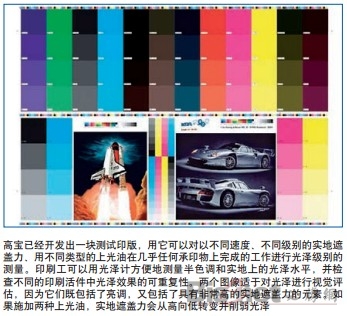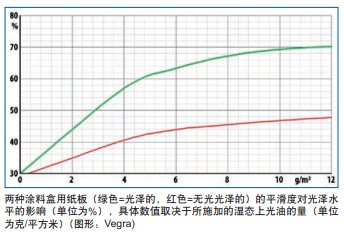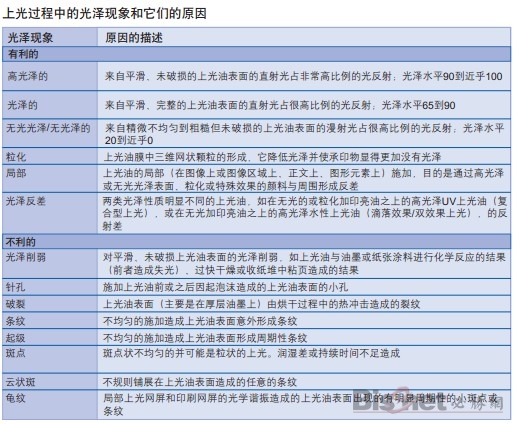The quality of online glazing is defined by the level at which the desired optical, tactile, mechanical or chemical effect is achieved. This chapter summarizes the most important factors that affect gloss formation, wetting ability, and processability.
Gloss quality
The gloss levels from high gloss to matte gloss, clear and transparent, and no yellowing are all optical properties, and the smooth and finely structured surface is the tactile property often mentioned. Gloss is a visual impression that indicates the smoothness of a surface. It is generated by the reflection of light. Diffuse light is not as strong as direct light, which belongs to the gloss angle, that is, the reflection angle, which is equal to the incident angle but opposite. If the holes in the rough surface topography are filled or completely covered by similar media (such as paint), the diffuse light will be reduced.
The gloss intensity is measured with a gloss meter (reflectometer) at different angles: ISO 2813 (DIN 67530) specifies a high gloss surface of 20 ° / 20 °, a standard surface of 60 ° / 60 °, and a matte surface of 85 ° / 85 °. For many years until now, 45 ° / 45 ° has been preferred in the printing and packaging industry, and of course, 60 ° / 60 ° is often used to check glazed prints. So be sure to mark the angle used together with the measured value. The measured value is the same as the reflectometer value, gloss level or gloss value. They are between 0 (completely diffuse reflection, completely matte gloss) and 100 (completely direct reflection, completely glossy), or given as a percentage or not. Not commonly used in practice is the visual gloss number (DIN 16537), which is between 0 (matte) and 10 (glossy). Haze is usually determined in the United States (ASTMD 4039). This is the difference between 60 ° and 20 ° gloss (H = R60-R20). It can measure haze more accurately, especially on standard and high gloss samples.

However, only the measurement on the newly glazed print can show very little: it is best to use the KBA gloss test plate on the substrate actually used in the printing work (with 64 large measurement areas) Gloss measurement after printing and after online glazing with a prescribed varnish, such as measurement at four different intervals: immediate measurement of the 5,000th printed sheet and measurement after 72 hours, immediate measurement of the 10,000th printed sheet And the measurement after 72 hours. The four gloss curves thus obtained allow you to make inferences about the quality of the gloss you can expect, so you can take steps as needed to influence the results obtained by changing the substrate, ink, varnish or anilox roller. The gloss curve should also include the gloss value of the unprinted, unglazed substrate, because it provides an initial reference for increasing or decreasing the gloss level.
The main factor affecting the gloss is the substrate and its inherent gloss. After glazing, if the ink does not chemically react with the varnish (gloss effect), its gloss will increase. If the viscosity of the varnish supports spreading, a continuous part can be inserted into the extended take-up device to extend the duration, so that the gloss can be promoted without compromising the production speed. Decreasing the stack temperature and slowing the drying process can also improve gloss. Conversely, higher stack temperatures will cause gloss damage due to sticking. Other factors and phenomena are described in detail in the table and practical tips.

Wetting quality
The key parameters for proper wetting of the substrate with varnish to produce a perfect varnish film without producing "orange peel" have been examined in the chapters on rheology and anilox rollers. First, the varnish, anilox roller, glazing plate and substrate must have the correct interfacial tension between each other (not only to ensure reliable adhesion of the varnish film), the varnish must have the correct viscosity, And the anilox roller must have a properly engraved surface that can apply the required varnish volume in the wet state. A large volume of varnish is required to produce gloss, but too much varnish cannot be spread correctly.

The temperature has a very large influence on the viscosity and thus the amount of varnish applied, so it is important to comply with the operating temperature specified by the varnish manufacturer. In this regard, metallic glazing oils have higher requirements because they must work below 27 ° C (81 ° F) to protect the luster of the pigment. Additives, such as silicones for UV varnishes or slip agents for special applications, often change the viscosity set by the manufacturer. In order to avoid unpleasant accidents due to wrong dosage or in complex finishing and bronzing, it is recommended to consult with the manufacturer, and may request to test the glazing operation. Perfect wetting may be damaged during drying or curing. Excessive heat can cause the water-based varnish on dark images to crack or produce small cracks-see the practical tips.
Workability
Trouble-free operation starts with proper storage. Frost mainly damages water-based varnish, and UV varnish must be stored in a light-tight container. If the water-based and UV varnish mixed with special effect pigments are stored for as long as the standard varnish, the quality will be impaired.
The adjustments made before and during application include preparation of the varnish in accordance with the parameters specified by the manufacturer. This includes temperature, viscosity, and even particle distribution through thorough foam-free agitation. Varnishes with special effect pigments should be further agitated during the production process. If properly adjusted, the varnish can be easily pumped without foam or oil mist and has the required surface tension. If production is interrupted for a period of time, the varnish in the varnishing unit will be slightly dry due to evaporation.
The amount of varnish applied should be the result of a compromise between the desired effect, saving of varnish consumption and minimum radiation input. If the thickness of the applied varnish film is more than necessary, it will not only cause excessive consumption of varnish and energy, but also have an adverse effect on the substrate and weaken the drying or curing effect, thereby causing rubbing in the paper stack Dirty and sticky pages. If the applied varnish layer is thin, there is usually no need to perform a dusting operation that would impair the quality of the varnish. Of course, it is important to apply a thin layer of oil when glazing on both sides. Rainbow, metallic and blistering varnish will cause greater pollution in the glazing unit, especially around the anilox roller.
The choice of varnish also affects the finishing of the printed matter. Many varnishes combine multiple functions, but for specialized features, such as sliding in packaging lines, it is best to use high-slip varnish or poker varnish instead of standard gloss varnish . Measuring the sliding angle of two sheets of paper placed on top of each other on an inclined surface will show the suitability of glazing, or conversely, the suitability of this application. And not all gloss varnishes are equally scratch and rub resistant. If in doubt, test the material, for example, to see if the water-based varnish is compatible with a specified adhesive, or whether it can be subsequently gilded on a UV varnish.
When choosing a varnish, printers and their customers must consider environmental standards more, such as whether the varnish is harmless, and whether varnish residues and prints can be recycled and used? Or is it Biodegradable.
Cake Decorating icing spatula set- Spatula set could used for decorating a large cake or small cupcake.Stainless Steel Spatula also could used for icing desserts, frosting pastry, cookies, crepes, pies & cupcakes, picking up and carrying cakes or pizzas, sandwiches, even cutting curds.The Stainless Steel handle easy to be held and hang.
Stainless Steel Spatula
Steel Spatula,Stainless Spatula,All Clad Spatula,Metal Slotted Spatula
YANGJIANG SHENGHAI INDUSTRIAL&TRADING CO., LTD , https://www.shenghaiyj.com